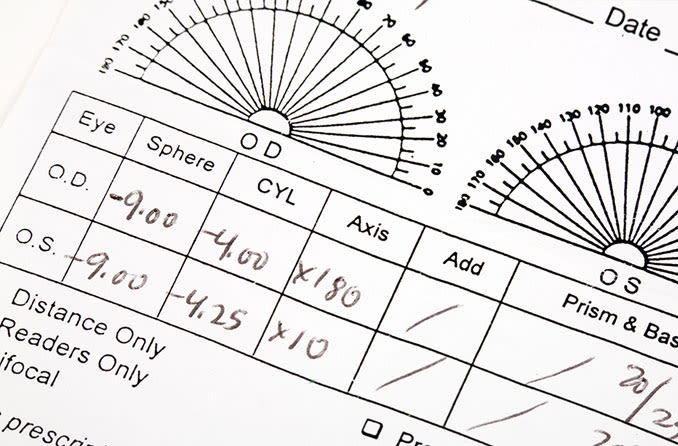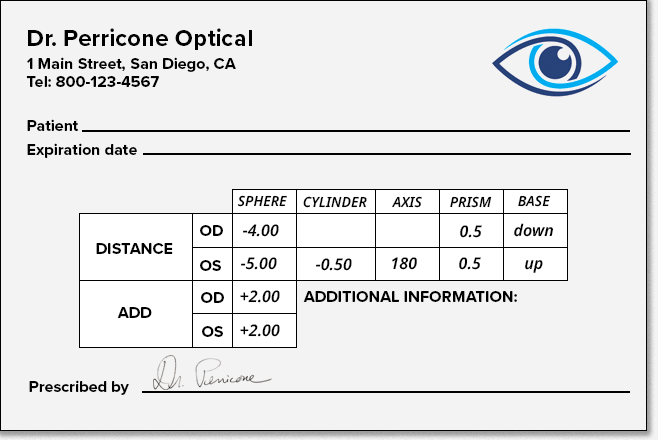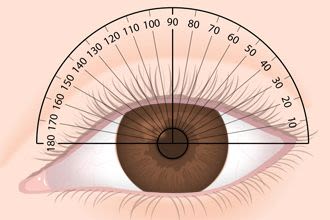How to Read Glasses Prescription for Prism Lenses
How to Read Your Eyeglasses Prescription

Making sense of your eye prescription chart
The numbers on your eyeglass prescription relate to the shape of your eyes and strength of your vision. They can assist you lot effigy out whether you take nearsightedness, farsightedness or astigmatism — and to what degree.
If yous know what to expect for, you can make sense of the numbers and abbreviations on your prescription chart.
OD vs. Os: 1 for each eye
Center doctors use the abbreviations "OD" and "OS" to denote your right and left eyes.
Your eye physician may give you a paper prescription that looks something like this. 
-
OD is your right middle. OD is short for oculus dexter, the Latin phrase for "correct eye."
-
Bone is your left eye. OS is short for oculus sinister, Latin for "left middle."
Your vision prescription may also have a column labeled "OU." This is the abridgement for oculus uterque, which means "both eyes" in Latin.
These abbreviated terms are common on prescriptions for glasses, contact lenses and eye medicines, simply some doctors and clinics take opted to modernize their eye prescriptions past using RE (right eye) and LE (left eye) instead of OD and OS.
The information for your right eye (OD) ever comes before the data for your left heart (Bone). Eye doctors write prescriptions this way because, when they face you, they meet your right eye on their left (kickoff) and your left eye on their correct (second).
Sphere (SPH)
Sphere indicates the amount of lens ability prescribed to correct nearsightedness or farsightedness. Lens power is measured in diopters (D).
-
If the number nether this heading comes with a minus sign (–), you are nearsighted.
-
If the number under this heading has a plus sign (+), you are farsighted.
The term "sphere" ways that the correction for nearsightedness or farsightedness is "spherical," or equal in all meridians of the heart.
Cylinder (CYL)
Cylinder indicates the amount of lens power needed for astigmatism. Information technology always follows the sphere power on an eyeglass prescription.
The number in the cylinder column may have a minus sign (for correction of nearsighted astigmatism) or a plus sign (for farsighted astigmatism).
If nix appears in this column, you lot either don't have astigmatism, or your degree of astigmatism is so small that information technology doesn't need to be corrected.
The term "cylinder" ways that this lens power added to correct astigmatism is not spherical, merely instead is shaped and so 1 meridian has no added curvature, and the tiptop perpendicular to this "no added power" acme contains the maximum power and lens curvature to right astigmatism.
Meridians of the eye are determined by superimposing a protractor scale on the heart's front surface. The 90-degree tiptop is the vertical height of the eye, and the 180-degree acme is the horizontal meridian.
Meridians of the eye are determined by superimposing a protractor calibration on the middle'south front surface. The 90-degree meridian is the vertical meridian of the eye, and the 180-degree tiptop is the horizontal meridian.
Axis
Axis describes the lens elevation that contains no cylinder ability to correct astigmatism.
If an eyeglass prescription includes cylinder power, it too needs to include an axis value, which follows the cylinder power.
The axis is defined with a number from ane to 180.
-
The number 90 corresponds to the vertical meridian of the center.
-
The number 180 corresponds to the horizontal acme of the heart.
The centrality is the lens summit that is 90 degrees abroad from the meridian that contains the cylinder ability for astigmatism correction.
Add
"Add together" is the added magnifying power applied to the bottom part of multifocal lenses to correct presbyopia — the natural farsightedness that happens with age.
The number actualization in this section of the prescription is always a "plus" power, fifty-fifty when you don't see a plus sign. Generally, information technology will range from +0.75 to +3.00 D and will exist the same ability for both eyes.
Prism
This is the amount of prismatic power, measured in prism diopters ("p.d." or a triangle when written freehand), prescribed to compensate for middle alignment problems.
Only a small per centum of eyeglass prescriptions include a prism measurement.
When nowadays, the corporeality of prism is indicated in either metric or fractional English units (0.5 or ½, for example), and the direction of the prism is indicated by noting the relative position of its "base of operations" (thickest border).
Four abbreviations are used for prism management: BU = base up; BD = base down; BI = base in (toward the wearer's nose); BO = base out (toward the wearer's ear).
How they're measured
Sphere ability, cylinder power and add together power e'er appear in diopters. They are in decimal class and by and large are written in quarter-diopter (0.25 D) increments.
Axis values are whole numbers from 1 to 180 and signify only a meridional location, not a power.
When prism diopters are indicated in decimal form, typically only one digit appears later on the catamenia (e.g., 0.5).
An example eye prescription chart
Even so confused? Let's await at an example prescription chart:
| SPH | CYL | Centrality | Add | Prism | |
|---|---|---|---|---|---|
| OD | -2.00 | SPH | +2.00 | 0.5 BD | |
| Bone | -1.00 | -0.50 | 180 | +2.00 | 0.5 BU |
In the right eye (OD), the eye doctor prescribed:
-
-2.00 D sphere for the correction of nearsightedness.
-
No cylinder power or axis, which means no astigmatism is present. This doctor chose to write "SPH," to ostend the right eye is being prescribed simply spherical ability. Some doctors will add together "DS" for "diopters sphere" and others will leave information technology blank.
The left eye (OS) was prescribed:
-
-1.00 D sphere for nearsightedness correction.
-
-0.50 D cylinder for the correction of astigmatism.
-
A cylinder power with an axis at the 180 elevation. This means that the horizontal (180-degree) elevation of the centre has no added ability for astigmatism and the vertical (90-degree) tiptop gets the added -0.fifty D from the cylinder column.
Both eyes were prescribed:
-
An "add power" of +2.00 D for the correction of presbyopia.
-
Prismatic correction of 0.five prism diopter in each eye. In the right centre, the prism is base down (BD); in the left heart, it's base up (BU).
Your eye physician may also write specific lens recommendations on your eyeglass prescription. They might suggest anti-reflective coating, photochromic lenses and/or progressive lenses to give you the most comfortable vision correction possible.
SEE RELATED: How "bad" is my prescription?
Tin can eyeglass prescriptions be used to buy contact lenses?
No, you cannot utilize your spectacles prescription to buy contact lenses.
An eyeglass prescription but works for the purchase of eyeglasses. It does not contain sure data that is crucial to a contact lens prescription.
That information tin can but exist obtained through a contact lens fitting, an additional procedure that tin can be performed during your heart doctor visit.
Eyeglass lenses are positioned at a distance from the optics, while contacts residue directly on the optics. That altitude affects the lens ability required for optics to focus properly.
In improver to the data in an eyeglass prescription, a contact lens prescription must specify the base of operations (central) curve of the back surface of the contact lens, the lens diameter, and the specific manufacturer and brand name of the lens.
Also, the power of an eyeglass prescription frequently is modified when determining the best contact lens power. This is considering eyeglass lenses are worn some distance (usually almost 12 millimeters) from the surface of the middle, whereas contact lenses rest straight on the cornea of the eye.
An accurate contact lens prescription tin be written only after a contact lens fitting has been performed and the prescribing md has evaluated your optics' response to the lenses and to contact lens wear in general.
SEE ALSO: Contact lens vs. eyeglasses prescriptions
Your eyeglass prescription is yours to proceed
The Federal Trade Committee (FTC) is the U.S. government's consumer protection agency. Their Prescription Release Dominion requires that heart doctors give patients a re-create of their eyeglass prescription at the stop of an eye examination that includes a refraction.
The Prescription Release Rule is intended to allow the "portability" of your eyeglass prescription, giving you the freedom to purchase glasses from any vendor of your choice.
Your eye md must give you a re-create of the prescription whether or not yous ask for it. Eye doctors may not condition the release of your prescription on your understanding to purchase eyeglasses from them, nor may they charge yous an extra fee to release your prescription.
If you lot think your centre md has violated this rule, you can written report the problem to the FTC.
Folio published in February 2019
Page updated in February 2022
streicherhurew1943.blogspot.com
Source: https://www.allaboutvision.com/eyeglasses/eyeglass-prescription.htm
0 Response to "How to Read Glasses Prescription for Prism Lenses"
Post a Comment